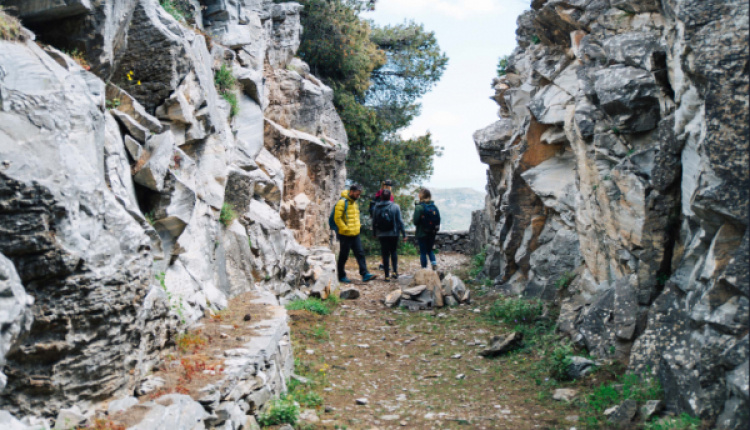Marble Marvels: A Historic Hike on Mount Penteli
- by XpatAthens
- Thursday, 06 May 2021

Mount Penteli is one of the four ranges that cradle Athens and at 1,006 metres, is the second highest summit after Mount Parnitha.
The mountain is world-famous for its marble which has long been prized for its purity. The marble quarries there operated from around the 6th century B.C. until the 1940s and yielded the vast bulk of the material used to build the Acropolis and the ancient city of Athens.
We’re headed for the Dionysos open-air marble museum, a reconstruction complete with crumbling miner’s shacks, tool sheds, and dramatic scree mounds, to drive home this mountain’s mighty marble legacy.
During the four hours or so we are up here, we encounter totally different landscapes; from gorgeous open panoramas and austere quarries to woodland meadows carpeted with wildflowers (and rare butterflies). There’s also a delightful trio of storybook chapels the size of Wendy houses, decorated with holy icons, and springwater taps where we top up our bottles with sweet mountain water.
It’s also about what we don’t see. As in other people. Barring a few faded red markings on rocks, Penteli is not a sign-posted route. It helps keep the crowds at bay.
After about 45 minutes, we emerge into a natural clearing backed by an imposing wall of multi-coloured marble rock. This is the climbing section of Penteli. Known as Dionysos, it’s among the most popular in Attica (wider Athens) and one of the few places in Greece where you can pit yourself against sheer marble precipices around 15-20m high.
We’re now standing at the mouth of a steep ramp-like track scattered with marble shrapnel. The path plunges like a black ski-run towards the lush foothills below. This is the platform they used to send marble blocks the size of a car down the mountain. They’d tie them up with cables; then release them slowly on ropes.
I try (and fail) to visualise the Herculean Endeavour of shifting all those mammoth marble bricks from here to the Parthenon building site, some 25 kilometres away.
Next, we stop near the stony reconstruction of what looks like an open-air “staff canteen” built into the sloping quarry, adjacent to the old tool construction area. That’s where they would place the dynamite to break up the rock in modern times. In ancient Greece, they soaked flints in water and stuck them into holes where they would expand and break up the marble.
Many of Penteli’s quarry workers hailed from Paros island. The Parians were good workers, apparently, and had a knack with marble (the legendary Venus de Milo was sculpted from Paros marble).
The Dionysos marble museum isn’t really a museum in the strictest sense. There are no maps or organised exhibits. It’s more of an atmospheric theatre set, built atop the retired ancient quarry to represent everyday working life.
We continue up the steady incline; marble debris clinking musically underfoot, like pebbles knocking together on a shore.
To read this article in full, please visit: thisisathens.org
Next, we stop near the stony reconstruction of what looks like an open-air “staff canteen” built into the sloping quarry, adjacent to the old tool construction area. That’s where they would place the dynamite to break up the rock in modern times. In ancient Greece, they soaked flints in water and stuck them into holes where they would expand and break up the marble.
Many of Penteli’s quarry workers hailed from Paros island. The Parians were good workers, apparently, and had a knack with marble (the legendary Venus de Milo was sculpted from Paros marble).
The Dionysos marble museum isn’t really a museum in the strictest sense. There are no maps or organised exhibits. It’s more of an atmospheric theatre set, built atop the retired ancient quarry to represent everyday working life.
We continue up the steady incline; marble debris clinking musically underfoot, like pebbles knocking together on a shore.
To read this article in full, please visit: thisisathens.org
Photo by: Thomas Gravanis
Thank you This is Athens for your contribution as an XpatAthens Partner.
Whether you've just arrived in town – or have been here for years – Athens always has new secrets to share!
This is Athens is the official guide to this captivating city of ancient energies and booming urban culture. Compiled by a team of specialist local writers, This is Athens brings you an authentic and intimate portrait of a living Athens beyond the guidebooks – along with daily curated listings of all the best events and great weekend inspiration all-year round. From must-know neighbourhoods and emerging art hubs, to gourmet hotspots, cool shopping and the buzziest bars, This is Athens will help you to get the most out of living in Athens!
Thank you This is Athens for your contribution as an XpatAthens Partner.



